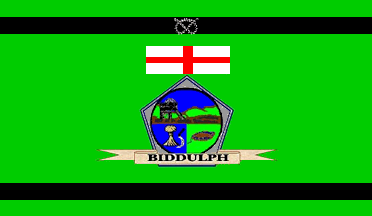 image by Adrian Thomas, Flag Designer, 24 December 2005
image by Adrian Thomas, Flag Designer, 24 December 2005
Last modified: 2021-02-06 by rob raeside
Keywords: biddulph | staffordshire |
Links: FOTW homepage |
search |
disclaimer and copyright |
write us |
mirrors
 image by Adrian Thomas, Flag Designer, 24 December 2005
image by Adrian Thomas, Flag Designer, 24 December 2005
On this page:
See also:Biddulph is a town in a valley in the south of Staffordshire. The town's name came from the Anglo-Saxon bi dylfe which means "beside the pit or quarry." The town and valley around it contains lots of natural resources, trees, rocks and minerals and evidence of ancient quarrying and old quarry sites are quite evident.
The valley is also a major watershed for much of England with water flowing away in all directions. For example, one of the Trent River's main sources is Biddulph Moor and from there it makes its way to the east coast of England. Other streams flow to the north and eventually arrive on the west coast and the Irish Sea.
The area around Biddulph has been inhabited for at least 5000 years and the remains of an ancient burial place
are near. The Anglo-Saxons settled the valley around 650 and they found rich deposits of coal and iron. The Vikings raided and visited leaving place names behind them when they did. They were followed by William the Conqueror and the Normans who built their network of fortifications (castles) and wooden buildings across the Biddulph Valley. In later centuries
at least four manors were built in and around the town. By the end of the 12th century the pottery industry was well established and flourishing because of the valley's clay deposits. In the 13th century much of the land around Biddulph came under the control of the monastery at Abbey Hulton. Sheep were grazed here and many places owe their names to that time.
As time passed the villages and hamlets of the Biddulph Valley were brought
together and the name of Biddulph became the name of the town formed in the valley.
Peter Loeser, 2 February 2021
The flag is green with two horizontal black stripes, the upper one containing a Stafford knot. The shield of the town bears a round seal, divided per fess, above a colliery scene, below divided per pale on the left a sheaf and sickle on blue, on the right a brown shuttle on green. Behind the seal is a grey pentagon, and over all is a ribbon stating BIDDULPH. Above the shield is a St. George's cross flag.
I designed it for the town council. The black stripes represent the coal mining industry, and the green field the green of Biddulph Moor. The St. George's cross flag on the Biddulph flag is because the town is in England.
Adrian Thomas, 24 December 2005
One line (and only one line) in a report of a Town Council meeting on the web site of the Biddulph Chronicle states as follows: "The design for the Biddulph flag was chosen from the examples submitted." This report is dated 18th February, but no year is provided.
Colin Dobson, 26 December 2005
There is no official or independent confirmation from the local authority of which this flag represents, nor as of this date has the flag been registered at with The Flag Institute.)
Colin Dobson, 17 April 2006